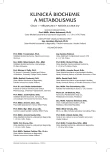Antibody structure and its reactivity.
Authors:
P. Štern
Authors‘ workplace:
Mimoňská 637/16, 190 00 Praha
Published in:
Klin. Biochem. Metab., 24, 2016, No. 1, p. 4-9
Overview
The educational publication describes the antibody structure, various fragments, three-dimensional fixation of domains, the function of disulfide bridges, β-strands and hypervariable loops. It also deals with differences between individual immunoglobulins and their isotypes. The antigen-antibody reaction is interpreted in the aspect of complementarity of reactants, as well as various binding forces participating in the energy of the immunochemical bond. Differences between the antibody bond to immunogen or to hapten and characteristics supporting the immunogenicity of antigen are given as well. Both the relation between the affinity and specifity of immunochemical reaction and the reactivity of naive and mature antibodies are demonstrated.
Keywords:
affinity, antibody, antigen, immunoglobulins, specificity.
Sources
1. Elgert, K. D. Immunology: Understanding the Immune System, Chpt. 4, Wiley 1998.
2. Smith, K. C. Antibody Structure and Function. Immunology Syllabus, p. 48 – 71, University of Texas Medical School at Houston 2014.
3. Alberts, B. et al. Essential Biology, 2nd Edition, Garland Science Publishing 2004.
4. Wozniak-Knopp, G. et al. Introducing antigen-binding sites in structural loops of immunoglobulin constant domains: Fc fragments with engineered HER2/neu-binding sites and antibody properties. Protein Eng. Des. 2010, Vol. 23, No. 4; p. 289–297.
5. Smith, K. C. Antigen-Antibody Interactions. Immunology Syllabus, p. 145-160, University of Texas Medical School at Houston 2014.
6. Goldsby, R. A. et al. Immunology, 5th Edition, Chpt. 4, Freeman and Comp., New York 2003.
7. Kalsi, J. at al. Structure-function analysis and the molecular origins of anti-DNA antibodies in systemic lupus erythematosus. Expert Reviews in Molecular Medicine p. 1-28, Cambridge University Press 1999.
8. Vidarsson, G. et al. IgG Subclasses and Allotypes: From Structure to Effector Functions. Front Immunol. 2014, Vol. 5, p. 520.
9. Parham, P. The Immune System, 3rd Edition, p. 249-288. Garland Science, New York 2009.
10. Immunology and Microbiology. MSc Programme in Human Biology, Biology Exams 4 U. University of Copenhagen 2015.
11. Wiersma, E. J. et al. Structural and Functional Analysis of J Chain-Deficient IgM. J. Immunol. 1998, Vol. 160, p. 5979-5989.
12. Hewitt, C. R. A. Structural Biology and Functions of Immunoglobulins. University of Leicester 2005-2006.
13. Smith, K. C. Antibody structure and function Part I. Medic Immunology, University of Texas Medical School at Houston 2014.
14. Janeway, C. A. Jr. et al. The interaction of the antibody molecule with specific antigen. Immunobiology: The Immune System in Health and Disease. 5th Edition. Garland Science, New York 2001.
15. Frank, S. A. Specificity and Cross-Reactivity. Immuno-logy and Evolution of Infectious Disease, Chpt. 4. Prin-ceton University Press, Princeton (NJ) 2002.
16. Lewis, D. Antibody structure. Mofet Institute, Tel Aviv 1998.
17. Peng, H. P. et al. Origins of specificity and affinity in antibody–protein interactions. Biophysics and Computational Biology 2014, p. E2656-E2665.
Labels
Clinical biochemistry Nuclear medicine Nutritive therapistArticle was published in
Clinical Biochemistry and Metabolism

2016 Issue 1
Most read in this issue
- Antibody structure and its reactivity.
- Criteria of analytical quality measurement in clinical biochemistry. Current international consensus and its implications for routine action of clinical laboratories.
- Influence of IGF1 (insulin-like growth factor 1) signaling pathway to the development of cancer diseases
- IGF1 (insulin-like growth factor 1), basic characteristics, biological effect, age and gender dependence
